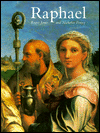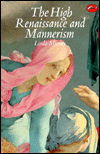|
Recommended Readings
|

Raphael
by Roger Jones, Nicholas Penny (Contributor)
An excellent survey of the artist's career.
More info
Buy now
|

Michelangelo (World of Art)
by Linda Lefevre Murray
Contemporaries saw Michelangelo as the greatest artist of all times, recognizing in his creations an inspiration more divine than human. Today our appreciation of Michelangelo's sublime vision, and of his matchless gifts as sculptor, painter, architect and poet, has been strengthened and enriched by the perspective of four centuries. And Michelangelo himself has become the archetype of genius--dedicated, solitary, single-minded, tormented, harassed, unsatisfied and undefeated. In this lucid and authoritative survey, Linda Murray explores the political and religious context of his career, the recurring themes in the work, and the complex symbolism and iconography of his greatest masterpieces.
More info
Buy now
|

The High Renaissance and Mannerism: Italy, the North and Spain, 1500-1600 (World of Art)
by Linda Lefevre Murray
The principal elements of High Renaissance art, first formulated by Leonardo da Vinci in the 1490s, came to their true flowering in the brilliant achievements of Bramante, Raphael and Michelangelo in Rome, of Michelangelo in Florence and Giorgione and Titian in Venice. After the death of Raphael in 1520, the next generation in Italy was to see the rise of the complex and refined sensibility summed up in the term "Mannerism." In this uniquely comprehensive guide to sixteenth-century Renaissance art, Linda Murray examines the manifold achievements of Italian artists and identifies the individual forms taken by artists in Northern Europe and in Spain, including Durer, Bruegel and El Greco.
More info
Buy now
|
|
      
|
Classical Antiquity influences
Classical antiquity was a major influence on all branches of the art of the Italian Renaissance, as there was a revival of interest in the Ancient Greek and Roman civilizations. The Italians at the times were haunted by their splendid past. They admired the classical art and they were also firmly convinced that art had its own rules which had been discovered and applied in Ancient Greece and Rome and subsequently forgotten.
...more 
|
|
Idealization
The year 1500 marks a subtle shift in artistic style and objectives. To Vasari, writing in 1550, the key to the new artistic style was razia, meaning a refined grace and ease of manner. Even the most contrived details were made to appear effortless and unforced. Although artists aimed at increasing realism, a pedestrian realism was not the mark of the highest art. An aesthetic illusion of reality became the predominant aim of the High Renaissance.
...more 
|
|
Madonna and Child Theme
Over the course of his Florentine years, Raphael painted a number of versions of the Virgin with Christ and the young John the Baptist in a landscape. In his art, noble individuals move with dignity and grace through a calm, intelligible, and ordered world. His pictures mirror Renaissance aspirations for human conduct and Renaissance goals for the human mind.
...more 
|
|
|
|
Patronage
There were two main systems of patronage in Renaissance Italy. A rich person could take an artist into his or her household and in return the artist would supply the patron artistic needs, or someone or some organisation could commission a single work from an artist and employ him until that work was finished client. If the commissioned work was particularly complicated the artist could be on the client payroll for years.
...more 
|
|
The Portraits
In the last decade of the fifteenth century the independent portrait finally emerged as an autonomous work of art. The general revival of descriptive art in the Renaissance signaled a return to portraiture and to such antique portrait forms as the medal and the bust. Initially, the role of the Renaissance portrait was commemorative. This was in line with the Renaissance belief that human beings were important in themselves and deserved to be recorded and remembered.
...more 
|
|










